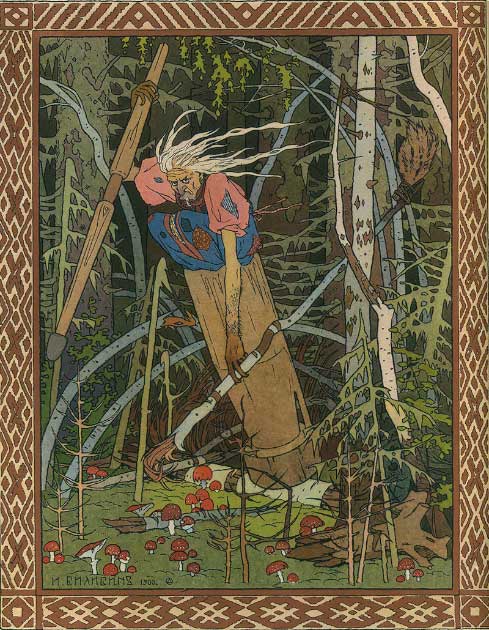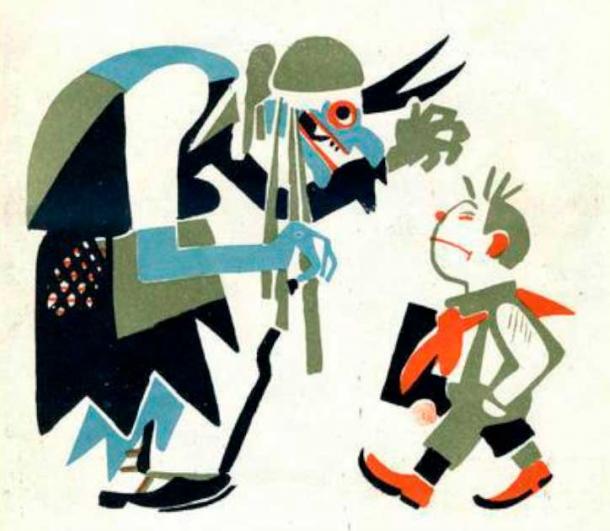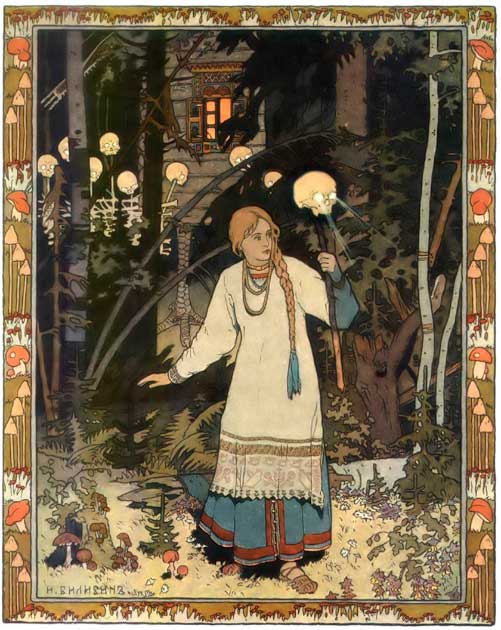
Baba Yaga: The Wicked Witch of Slavic Folklore
As ambiguous as she is hideous, Baba Yaga is an anomaly. In Slavic folklore, Baba Yaga is both a maternal, mother nature figure and an evil villain who kidnaps and eats children. Numerous renditions of her tale portray her as a harbinger of transformation, possessing the power to either assist or obstruct those who she chances upon, and eating those who fail to satisfy her demands. An alternative wicked witch from Russian and Slavic legends, Baba Yaga is depicted as flying through the forest within a giant mortar and pestle.
Though the origins of her name are as unclear as her purpose tends to be, it is believed that baba means something akin to “old woman” or “grandmother,” while the meaning yaga is said to mean anything from “snake” to “wicked.” Regardless, even Baba Yaga’s name emphasizes the strangeness of her person, making her an interesting character to decipher.
- A Freaky Fairy Tale of Ancient Folklore: Vasilisa the Beautiful and Baba Yaga
- Domovoi: Stay on the Good Side of This Mischievous Slavic House Sprite
The story of Baba Yaga was first recorded in writing in 1755, though legends about her appeared far earlier and can be evidenced in artworks from at least the 17th century. Modern day interpretations, such as Into the Forest: Tales of the Baba Yaga, have emphasized her role as a possible “proto-feminist icon.”
“The essence of Baba Yaga exists in many cultures and many stories, and symbolizes the unpredictable and untamable nature of the female spirit, of Mother Earth, and the relationship of women to the wild,” explained Ryan, the editor of the collection, in an interview with the BBC. “She's a shamanic trickster, a category and boundary-crosser, a [reminder] that freedom lies a little beyond the border of social norms, and that we can learn as much from the dark as the light.”

Baba Yaga in her mortar, by Ivan Bilibin. (Public domain)
Depictions of the Mythical Baba Yaga
The most common portrayal of Baba Yaga is as either one old woman or a trio of old sisters, all of whom are depicted as skinny, with iron teeth and noses so long that they touch the ceiling when they sleep. Baba Yaga is commonly illustrated as riding around on a mortar rather than a broom, wielding a pestle as both a flying aid and a wand.
Stories about the Baba Yaga abound, with most of them taking place within her hut located deep in the woods. To make the story even more eerie, legend has it that her hut was surrounded by a fence made of human bones and stood on magical chicken legs, with a rooster's head on top.
Tales about Baba Yaga usually recount that heroes daring to enter her humble abode would find her draped across her cooking stove. The enormous stove is described as reaching from one side of the hut to the other, subtly emphasizing her size and magical powers.
The stove is another common detail included in tales of the Baba Yaga, as the location where her victims are cooked and eaten. Despite an ambitious appetite, however, Baba Yaga is always portrayed as skinny and bony, with her own epithet of “the bony one.”
Benefactor or Villain? The Ambiguous Character of Baba Yaga
The majority of well-known narratives featuring Baba Yaga revolve around the heroes who cross her path, rather than her own personal exploits. It is the characterization of Baba Yaga that contributes to much of the ambiguity surrounding her, as she oscillates between assuming the role of a benefactor and a villain, either aiding or obstructing the heroes of Slavic folklore.
While it seems that Baba Yaga never initiates any confrontations, as she only reacts when someone ventures to her hut, her moral compass appears to be all but absent. Yet, regardless of her questionable ethics, she remains true to her word and keeps whatever promise she makes to the hero who triumphantly completes her assigned tasks.
The eerie and unpredictable nature of Baba Yaga only adds to the gripping mystery of her character, making her encounters with Slavic heroes all the more thrilling and unpredictable.

Illustration of Baba Yaga from 1925 by Ivan Malyutin. (Public domain)
Baba Yaga in the Tale of Vasilisa the Beautiful
In one story known as Vasilisa the Beautiful, Vasilisa is a Cinderella-type character with a magical doll, whose mother died and father remarried a horrible woman with equally unkind daughters. When Vasilisa's father goes away for a trip, the new stepmother sells their house and moves her and the three girls to a cottage in the woods, giving the daughters impossible tasks to complete by candlelight.
When Vasilisa heeds her stepsisters' demand to find fire for their home, she unwittingly stumbles upon Baba Yaga, who assigns her a series of arduous tasks in exchange for a flame to bring back to her family. With the aid of the magical doll, Vasilisa triumphantly completes all the challenges and is rewarded with a fire ensconced in a skull lantern, which promptly incinerates her vile stepsisters upon her return home.
Vasilisa's story ultimately concludes when the Tsar of Russia, or the King depending on which version of the story is told, falls deeply in love with her providing a classic happily-ever-after-ending. It is, however, the enigmatic role of Baba Yaga in the tale that truly captivates the imagination.
Within Vasilisa the Beautiful, Baba Yaga embodies both an obstacle and a savior for Vasilisa. Without the lantern, she would have remained trapped in the clutches of her malevolent stepfamily. However, Baba Yaga's gruesome methods of liberating Vasilisa underscore her amorality and hazardous nature.
Unlike the benevolent fairy godmother from the original Cinderella story, Baba Yaga evokes the wicked stepmother who allows her daughter to mutilate her own foot to fit the glass slipper. Baba Yaga goes to extraordinary lengths to free Vasilisa, exacting three agonizing deaths and causing her much distress before finally permitting her to leave the hut. Her actions surpass the mere task of helping Vasilisa escape her oppressive family, leaving a chilling impression of Baba Yaga's true motives and character.

The heroine Vasilisa outside of the hut of Baba Yaga as depicted by Ivan Bilibin (1902). (Public domain)
Baba Yaga as Mother Earth
Baba Yaga is also cast as a Mother Earth figure, having an influence on the natural world through three of her servants as witnessed by Vasilisa. Twice Vasilisa sees three riders — the first white, the second red, and the third black. Upon asking who they were, Baba Yaga replies that they are Day, the Sun, and Night, respectively, each controlled by her.
This particular episode of the story showcases the vast extent of Baba Yaga's power, hinting that she possessed the ability to liberate Vasilisa from her family's grasp with less extreme measures. However, her decision to employ such gruesome tactics emphasizes her malevolent nature and a propensity for ruthless behavior.
Baba Yaga and the Peasant Children
Another fable featuring Baba Yaga involves two hapless peasant children who are victimized by a tyrannical stepmother. In this narrative, the wicked stepmother sends the children to Baba Yaga’s abode, hoping to be rid of them for good.
The resourceful youngsters are aided in their escape by the animals, plants and objects Baba Yaga has neglected. A black cat helps them plan their escape, as they had been feeding him while Baba Yaga had not; a gate shuts Baba Yaga out because she had neglected it; Even the forest trees obstruct her path because of her similar mistreatment.
- She Brings Bad News: The Scary Slavic Household Spirit Called Kikimora
- The Snow Maiden of Slavic Folklore: Magical Characters of Winter from Russia
The children successfully return home unscathed, and Baba Yaga abandons her pursuit when it becomes too difficult. Again, this tale ends happily, with the father banishing the cruel stepmother and protecting his children. Once more, Baba Yaga’s role is that of an obstacle, only bothering the children because they first trespassed into her domain.
This illustrates a paradoxical aspect of Baba Yaga’s character, as she is often regarded as a deity who embodies the power and unpredictability of Mother Nature. Despite being considered a deity akin to Mother Nature, the natural world still turns against her due to the pain she has inflicted upon it. This is one of the reasons why scholars find it challenging to categorize her as she falls into many different roles and demonstrates contradictory traits.
Baba Yaga's enigmatic character is what makes her such a captivating figure in mythology and the subject of ongoing scholarly research. Her ambiguous nature leaves readers wondering whether she will act as a malevolent force or a benevolent savior in the various tales in which she appears.
Top image: Sculpture depicting the gnarly-faced character of Baba Yaga. Source: Public domain
By Ryan Stone
References
Afanasev, A. 1976. Russian Fairy Tales. Pantheon Books: New York.
Barnett, D. 20 November 2022. “Baba Yaga: The greatest 'wicked witch' of all?” in BBC. Available at: https://www.bbc.com/culture/article/20221118-baba-yaga-the-greatest-wicked-witch-of-all
de Blumenthal, V. X. K. 2009. Folk Tales from the Russian. BiblioBazaar: South Carolina.
Illes, J. 2009. Encyclopedia of Spirits: The Ultimate Guide to the Magic of Fairies, Genies, Demons, Ghosts, Gods & Goddesses. New York: HarperOne.
Johns, A. 2004. Baba Yaga: The Ambiguous Mother and Witch of the Russian Folktale.
Ryan, L. 2022. Into the Forest: Tales of the Baba Yaga. Black Spot Books.
Wheeler, P. 1912. Russian Wonder Tales. New York: The Century Company.
















Comments
My apologies for the duplicate. I would remove it if I could.
The proto-feminist slant is interesting. Some of those promoting and funding feminism are also behind child trafficking...
And very active in north-eastern Europe. Patterns emerge if one bothers to look. Two patterns that do emerge are the misuse of religion and myth, and of fine egalitarian principles, in order to deceive and control. The intended result is religious domination that is the antithesis of egalitarianism.
This is possible for people are easily hornswoggled. They tend to believe what they want to believe. Many today believe the Vatican to have been totally against transgenderism or 'gender' manipulation for a very long time, for example. Yet, the Vatican had a history of using castrated boy singers, even in the Sistine Chapel. This horrendous child abuse was deemed to be acceptable as they supposedly sang like angels. This is not unlinked to the first two paragraphs. It is high time people woke up to the deception that abounds.
The fine principles that many today grasp so keenly are usually twisted beyond redemption. Most hardly notice and not only grasp them wholeheartedly anyway, but demonise those who do not. Even those who see themselves as immune to this, often simply fall for a more complicated version of the same deceit.
In short, I would be wary of trusting any popular modern interpretation of this Slavic legend.
The proto-feminist slant is interesting. Some of those promoting and funding feminism are also behind child trafficking...
And very active in north-eastern Europe. Patterns emerge if one bothers to look. Two patterns that do emerge are the misuse of religion and myth, and of fine egalitarian principles, in order to deceive and control. The intended result is religious domination that is the antithesis of egalitarianism.
This is possible for people are easily hornswoggled. They tend to believe what they want to believe. Many today believe the Vatican to have been totally against transgenderism or 'gender' manipulation for a very long time, for example. Yet, the Vatican had a history of using castrated boy singers, even in the Sistine Chapel. This horrendous child abuse was deemed to be acceptable as they supposedly sang like angels. This is not unlinked to the first two paragraphs. It is high time people woke up to the deception that abounds.
The fine principles that many today grasp so keenly are usually twisted beyond redemption. Most hardly notice and not only grasp them wholeheartedly anyway, but demonise those who do not. Even those who see themselves as immune to this, often simply fall for a more complicated version of the same deceit.
In short, I would be wary of trusting any popular modern interpretation of this Slavic legend.
The proto-feminist slant is interesting. Some of those promoting and funding feminism are also behind child trafficking...
And very active in north-eastern Europe. Patterns emerge if one bothers to look. Two patterns that do emerge are the misuse of religion and myth, and of fine egalitarian principles, in order to deceive and control. The intended result is religious domination that is the antithesis of egalitarianism.
This is possible for people are easily hornswoggled. They tend to believe what they want to believe. Many today believe the Vatican to have been totally against transgenderism or 'gender' manipulation for a very long time, for example. Yet, the Vatican had a history of using castrated boy singers, even in the Sistine Chapel. This horrendous child abuse was deemed to be acceptable as they supposedly sang like angels. This is not unlinked to the first two paragraphs. It is high time people woke up to the deception that abounds.
The fine principles that many today grasp so keenly are usually twisted beyond redemption. Most hardly notice and not only grasp them wholeheartedly anyway, but demonise those who do not. Even those who see themselves as immune to this, often simply fall for a more complicated version of the same deceit.
In short, I would be wary of trusting any popular modern interpretation of this Slavic legend.
The figure of Baba-Yaga has long been unraveled by Slavic folklorists. She did not symbolize evil, but was the first to die - the very first deceased of the Slavic people. Hence her external description, which is found in folklore: one bony leg (a hint of skeletonization), organs falling out of her back, her recumbent position. The fact that her nose is resting against the ceiling of the hut means that she is lying down and her hut is a coffin because of the cramped space. The very description of the hut even suggests that it is an ancient type of burial: the hut was described as standing on its fumed legs. Among ancient hunters, there were burials where coffins were fumed and placed on special piles so that wild animals would not tear away the remains of the deceased.
In folk tales, Baba-Yaga, as the first to die, is the border guard between the world of the living and the dead, and helps the main character or heroine how to pass trials in the world of the dead. She helps/coaches because the heroes are her descendants. The transition of the heroes to the world of the dead in these tales is a rite of initiation, that is, it is not a real death, but a symbolic one. After it, the boy is reborn as a man, the girl as a wife. The Baba-Yaga began to receive negative connotations only in the author's fairy tales, when the original image of the character began to be forgotten with the retreat of paganism.
Pages